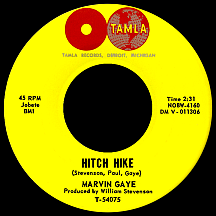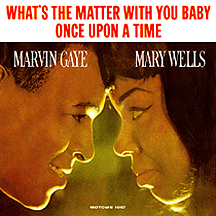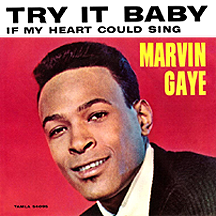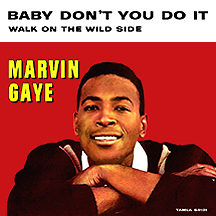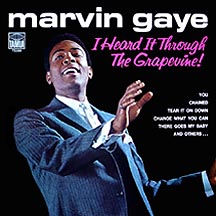MARVIN GAYE
The career of Marvin Gaye wasn't particularly consistent. His diverse musical interests were often at odds with religious beliefs, and a private life inseparable from his art, that made things all the more complicated. His was an anguished soul; choices were often rooted in frustration. Early in his association with Motown he had little control; at one point he took the reins completely, yet still struggled with personal issues only he could resolve. There were many moments of brilliance interrupted by a sudden, devastating end. Decades later his legacy is still strong, nor is it likely to fade any time soon.
One of five children, he was born Marvin Pentz Gay, Jr. in 1939. His family lived in the Washington, D.C. projects (or "The Slums," as he so frankly referred to them). The senior Marvin was a minister, a strict Christian fundamentalist who rejected as many of the customs of the modern world as possible (with occasional lapses into worldly temptations). Young Marvin planned to be a minister one day like his father, a goal he never made good on but never quite gave up on. The relationship between overbearing father and dutiful (but sometimes rebellious) son was difficult, to say the least.
Marvin spent much of his childhood and teenage years on the streets and developed a love of doo wop harmony that overrode all other interests. A shy guy, he sought to meet young women through his singing, patterning his style, in part, after Rudy West of The Five Keys. Other favorites were Ray Charles, Little Willie John, Clyde McPhatter, pop singer Perry Como and perhaps his favorite of all, Frank Sinatra. Marvin played piano by ear and was very good despite a lack of training. He sang with a friend from the projects, Reese Palmer; while students at Cardozo High School they formed a short-lived group, The DC Tones, with classmate Sondra Lattisaw.
Anxious to make a change (more specifically to get away from his father), Marvin joined the Air Force in 1955, but the strictness of military service didn't suit him and he requested and received an honorable discharge after a little more than a year. On returning, he joined Palmer's new group The Marquees (with James Nolan and Chester Simmons) as second tenor and baritone. The quartet auditioned for Bo Diddley in D.C., where Bo had previously discovered Billy Stewart, and made a couple of records for the Okeh label, backing Stewart on "Billy's Heartache" and following with their own "Wyatt Earp" (recorded the same day), a midtempo ode to "The King of the West" with Palmer on lead and Diddley on guitar. The late '57 single release didn't make much of an impression.
Harvey Fuqua needed singers for his Cleveland-based hot property The Moonglows (firmly established with "Sincerely," "See Saw" and other hits) when the Marquees crossed his path in '58; he hired them as his new group along with former Dells bass Chuck Barksdale (despite Simmons' presence as the Marquees' bass singer). Harvey and James Nolan (who replaced Bobby Lester, a cofounder, with Fuqua, of the group) alternated on lead, the other five mostly serving as backup. Harvey became a mentor to Marvin and their friendship became a lasting one. At Chess, the Moonglows' label, the Marquees performed on several hits including Diddley's "I'm Sorry" and two of Chuck Berry's best, "Almost Grown" and "Back in the U.S.A." A half dozen or more Moonglows tracks featured the group and two of these, "Twelve Months of the Year," credited to Harvey (with a spoken part by Gay), and "Mama Loocie" by Harvey and the Moonglows (with Marvin's lead vocal) were released.
By the early 1960s the Moonglows had run their course. Harvey headed for Detroit and started Tri-Phi Records with Gwen Gordy, later marrying her and unwittingly setting an example his young friend would emulate. Marvin showed up at the company owned by Gwen's brother, Berry Gordy, near the end of the year. Gordy and Gay met at a Christmas party marking Motown's first full year of operation; Marvin played piano and sang the famous Chordettes hit "Mr. Sandman." Berry was impressed with his talent and cool demeanor. Marvin worked as a session drummer for Tri-Phi and Anna Gordy's Anna Records; before long he joined the Motown staff, added an "e" to his name (as Sam Cooke had done a few years earlier) and set about getting his first record made for the Tamla label. It took awhile; he and the boss didn't fully see eye-to-eye.
Gaye kept busy with session work that first year, playing piano and drums on endless sessions (his drumming can be heard on The Marvelettes' hit "Please Mr. Postman"), working towards the his goal of making his own records. He wanted to do Sinatra/Como-style standards with a lean towards jazz, rejecting Gordy's priority: making hit records. But there was something about him Gordy liked and, with the urging of his sister Anna, who was passionately involved with Marvin by that time (despite being 17 years older), the young singer got his way with The Soulful Moods of Marvin Gaye, featuring pop standards like "Witchcraft" (a hit for Sinatra in '58) and "How High the Moon" (a decade-old Les Paul and Mary Ford hit), hardly your typical Motown fare. A single written by Gordy, "Let Your Conscience Be Your Guide," failed to generate interest in the project. Yet Marvin stubbornly stuck to his guns...for the time being.
Two singles followed: "Mr. Sandman," his fateful introduction to Gordy, and "Soldier's Plea," a spring '62 answer of sorts to The Shirelles' chart-topper "Soldier Boy," featuring Motown studio group The Love Tones. Marvin finally admitted these ballad-type things weren't working for him while the label's other acts were thriving with uptempo R&B recordings, so he went with his "backup plan" and gave Gordy what he wanted. William "Mickey" Stevenson and Berry's brother George Gordy wrote a song that described Marvin to a "T": "Stubborn Kind of Fellow." Not the least bit offended by this, Marvin offered ideas of his own during the creative process. Martha Reeves' girl group The Vandellas added to the dynamic, spontaneous-sounding session and received label credit; Marvin's vocals were calculatedly strained while Beans Bowles played flute, a trademark of early Gaye hits...of which this was the first. It landed in the middle of the pop charts and went top ten R&B in the fall of '62.
Stevenson, Gaye and Clarence Paul (Little Stevie Wonder's main man) came up with their take on a current dance, "Hitch Hike" (Chubby Checker's "Popeye the Hitchhiker" had gone top ten in November). Though the lyrics were more about the search for a missing girlfriend ('I've got to find that girl if I have to hitchhike 'round the world!'), a promo film featuring Gaye and the Vandellas (uncredited on the label this time) helped propel the song into the top 40 in March '63. Norman Whitfield worked with Stevenson and Gaye on the next single, "Pride and Joy" (the last with the Vandellas, on the verge of their own run of hits), a song that summed up his feelings for fiancee Anna Gordy. The two were married in June, a few weeks before the record became Marvin's first top ten pop hit. He was gaining momentum...personally and professionally.
Keeping an eye towards fulfilling his desire for pop and jazz stardom, Gaye casually accepted this early success. No other artist at Motown was so passé about the company's growing trademark soul sound, but as one hit song followed another he gradually embraced his newfound status. Other writers and producers at Hitsville wanted a piece of the action; not-yet-hot trio Eddie Holland, Lamont Dozier and Brian Holland composed "Can I Get a Witness" (the track featured backing vocals by H-D-H girls The Supremes), lyrically confusing to some, exciting to others. Motown promotion man Barney Ales predicted it would be a number one record. While it fell far short of that mark (dashing Marvin's high hopes), it was nevertheless a solid hit. "You're a Wonderful One" broke big in early '64, targeted directly to Marvin's growing number of female fans, a tactic that worked time and time again. Gordy came up with the idea of teaming his top male and female solo acts, resulting in two sides with Mary Wells, "Once Upon a Time" and "What's the Matter With You Baby." Both were top 20 hits just after Mary's number one smash "My Guy." An album followed and there surely would have been more had she not abruptly left Motown seeking greener pastures that never quite materialized.
"Try It Baby" (with vocal backup by The Temptations) was the next hit, written by Berry Gordy, who later admitted the song was about his secret affection for Supremes singer Diana Ross. Holland-Dozier-Holland's "Baby Don't You Do It" came in the fall of '64 - two action-packed years of hits and Marvin Gaye was riding high. He cowrote "Dancing in the Street" with Mickey Stevenson and it exploded for Martha and the Vandellas, a bigger seller than any of his own recordings thus far. As for his lost duet partner, a replacement was found in Kim Weston; "What Good Am I Without You" was disappointingly received by Gaye's normal standards but put Kim on track, paving the way for her solo hit, "Take Me in Your Arms (Rock Me a Little While)," the following year. Gordy tried out a third female singing partner, Oma Heard (she had one failed single on V.I.P. in '64), but decided they didn't click and several recordings the pair made went unreleased until many years later.
1965 was the biggest year yet as Gaye firmly established himself as Motown's top solo artist. Holland-Dozier-Holland, on a hot streak with the Supremes, embellished Jackie Gleason's four-word catchphrase with "How Sweet It Is (To Be Loved By You)," the first of two back-to-back top ten hits for Marvin. The Miracles got in on the act with "I'll Be Doggone," a Smokey Robinson-Pete Moore-Marv Tarplin track with attitude more suited to Gaye than their own group; in May, to Marvin's delight, it became his first number one hit on the R&B charts. The alluring Gaye-Paul-Dave Hamilton tune "Pretty Little Baby" had a softer romantic quality. Smokey and various Miracles collaborated on "Ain't That Peculiar" (another top ten) and lesser (but no less effective) '66 hits "One More Heartache" and "Take This Heart of Mine." H-D-H countered with "Little Darling, I Need You." In concert, Gaye relied heavily on older standards, much to Gordy's discomfort, but Hitsville's head man rewarded his star performer by allowing him to record pop-oriented albums; Hello Broadway and A Tribute to the Great Nat King Cole were two such projects released in '65, poor sellers when compared to his hit offerings, but worth the effort if for no other reason than to provide an outlet for Marvin's artistic desires.
If memory of the duets with Mary Wells and Kim Weston had faded by 1967, "It Takes Two" (written by Mickey Stevenson and Sylvia Moy) reaffirmed the strength of Gordy's initial duet concept. A fast-paced number recorded a year earlier, with infectious chemistry between Marvin and Kim, it hit big in the winter of '67, but any further possibilites were squelched when Weston and Stevenson, who had married by this time, left Motown for a supposed better deal with MGM. Tammy Montgomery was tapped to be Marvin's latest partner in show-biz romance; the Philadelphia-born singer made one record for Scepter in 1961 when she was 15, then joined James Brown's touring group, hitting the charts in August '63 with the Brown-Bobby Byrd song "I Cried" on JB's Try Me label. After a single on Checker several months later, she found work performing in a Detroit nightclub where Berry Gordy caught her act and signed her to Motown. Using a new stage name, Tammi Terrell, she made a minor splash with two '66 singles before she was teamed with Gaye and her fortunes changed markedly for the better.
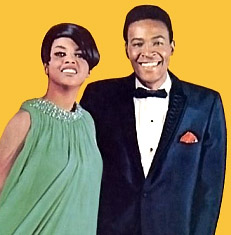
"Ain't No Mountain High Enough" kicked off an extremely popular series of hits for Marvin Gaye and Tammi Terrell (amazingly, the vocal tracks for this first single were recorded separately). Written by husband and wife Nickolas Ashford and Valerie Simpson, who knew a thing or two about how to convey undying love through song, the single went top 20 in July '67 followed by the top ten "Your Precious Love" a few months later, the songs so convincingly performed that just about everyone who didn't know better had little doubt Marvin and Tammi were romantically committed. Tammi, in fact, blossomed with these recordings that made her a star. Harvey Fuqua and Johnny Bristol produced the first three singles (including "If I Could Build My Whole World Around You," written with Vernon Bullock). Then Ashford and Simpson took over, penning and producing the rest of the way. Competition came from Peaches and Herb (who broke through at the same time as Gaye and Weston's "It Takes Two") and Peggy Scott and Jo Jo Benson (they debuted in mid-'68), but it was Motown's darling duo who dominated with "Ain't Nothing Like the Real Thing," "You're All I Need to Get By," "Keep on Lovin' Me Honey," "Good Lovin' Ain't Easy to Come By" and other smashes.
Meanwhile, outstanding solo efforts by Gaye (Ivy Jo Hunter, Jack Goga and Jeffrey Bowen's "You," Frank Wilson's "Chained") were only mid-chart hits, perhaps lost in the shuffle of the red-hot duet streak. A song Marvin recorded in 1966, "I Heard it Through the Grapevine," had been rejected at Motown's Friday morning "product evaluation" meetings, yet he kept urging Gordy to release it as a single, even after a faster-tempo version by Gladys Knight and the Pips had hit the top in late 1967. Norman Whitfield (cowriter of the song with Barrett Strong) agreed, arguing that it was a different arrangement and would work. Just a year after Knight's version, Gaye's "Grapevine" came out and was an even bigger hit...so big, in fact, that it was the best selling single so far for Motown and its subsidiary labels.
Whitfield worked his magic as he'd been doing with the Temptations, producing two more huge hits for Gaye in '69, "Too Busy Thinking About My Baby" and "That's the Way Love Is." Marvin dabbled in music production himself, composing (with help from his wife Anna, Elgie Stover and Johnny Bristol) and producing (with Richard Morris) two big hits for The Originals, the soulful ballads "Baby, I'm For Real" and "The Bells." Having gained confidence in this area, and encouraged by the string of funky, social commentaries Whitfield and the Tempts had been successful with, he adjusted his entire focus. Drastically changing his image at the start of the 1970s, he abandoned the stylish suits in favor of T-shirts and wool caps, grew a beard and began projecting a casualness similar to rock bands of the era. He wanted to create his own "protest" album about whatever subjects struck his fancy. Gordy was difficult to convince but finally gave him the green light...expecting that he would fail.
Tammi Terrell's death in March 1970, at age 24, left Marvin emotionally drained. Back in the fall of 1967, not long after the two had started singing together, she collapsed during a performance in Virginia. Diagnosed with a brain tumor, her health deteriorated rapidly and she stopped recording in 1969 (a fact kept secret from the general public as Gaye and Terrell records kept coming out until '70). Marvin rebounded as he set about the task of creating What's Going On, producing and writing all the songs himself, tackling timely topics like war, politics, racial prejudice and global conditions. When Gordy heard the first single's complex, layered production with Gaye's multitracked voice, he wasn't sure how to react (calling it "Marvin on top of Marvin on top of Marvin"), but "What's Going On" caught on with no problem, hitting number two pop and becoming his fifth number one R&B hit (on the renamed Soul chart) in the spring of '71. "Mercy Mercy Me (The Ecology)" and "Inner City Blues (Make Me Wanna Holler)," also went top ten pop and number one Soul. The album was one of the best-reviewed of the '70s and became a multi-million seller.
The success of What's Going On gave him freedom to go wherever his creative mind led. He scored with his instrumental soundtrack (and hit vocal title track) to the 1972 film "Trouble Man" (starring Robert Hooks), following the lead set by Isaac Hayes (with Shaft) and Curtis Mayfield (Superfly). "Let's Get it On," cowritten and produced by Ed Townsend, was an overt lyrical blend of sex and spirituality that became his second number one pop hit in September 1973. With a new duet partner, post-Supremes solo superstar and recent Oscar nominee Diana Ross, he revisited the charm of the earlier Mary/Kim/Tammi pairings, particularly with the 1974 hit "My Mistake (Was to Love You)."
In 1977, at the height of the disco era, he went against the trend with a straightforward dance record, "Got to Give it Up," and hit number one again. With all this creativity in full flower and the success it brought, there were often long periods between releases, creative lapses and bouts with drugs and depression. His marriage to Anna Gordy Gaye ended publicly with the release of a double album, Here, My Dear, a 73-minute ode to the good, and more prominently bad, in his marriage. Critics were generally positive in their assessments, but fans just went "What?" and the record was a flop. In retrospect, after the passage of many years, the album sounds pretty good.
Marvin's musical talent had few limits. Many facets of his personality were shared at different points in his 27-year career. Yet an air of mystery, part of what made him so fascinating, was always there. He left Motown in the early '80s and signed with Columbia Records. "Sexual Healing," sensually similar to, but going beyond "Let's Get it On," unexpectedly connected with the listening audience in late 1982. After eight nominations (going back to "Ain't No Mountain High Enough" in '67) but no wins, he received Grammys for the song in vocal and instrumental categories. On April 1, 1984, one day before his 45th birthday, his volatile relationship with the elder Marvin came to a head: his father shot and killed him during a family argument. It happened so abruptly. It still seems unreal. The world still mourns Marvin Gaye.
NOTABLE SINGLES:
- Wyatt Earp - 1957
by the Marquees - Mama Loocie - 1959
by Harvey and the Moonglows - Let Your Conscience Be Your Guide - 1961
- Mr. Sandman - 1962
- Soldier's Plea - 1962
- Stubborn Kind of Fellow - 1962
with The Vandellas - Hitch Hike - 1963
- Pride and Joy - 1963
- Can I Get a Witness /
I'm Crazy 'Bout My Baby - 1964 - You're a Wonderful One - 1964
- Once Upon a Time - 1964
by Marvin Gaye and Mary Wells / - What's the Matter With You Baby - 1964
by Marvin Gaye and Mary Wells - Try It Baby - 1964
- Baby Don't You Do It - 1964
- What Good Am I Without You - 1964
by Marvin Gaye and Kim Weston / - I Want You 'Round - 1964
by Marvin Gaye and Kim Weston - How Sweet It Is (To Be Loved By You) - 1964
- I'll Be Doggone - 1965
- Pretty Little Baby - 1965
- Ain't That Peculiar - 1965
- One More Heartache - 1966
- Take This Heart of Mine - 1966
- Little Darling, I Need You - 1966
- It Takes Two - 1967
by Marvin Gaye and Kim Weston - Ain't No Mountain High Enough - 1967
by Marvin Gaye and Tammi Terrell - Your Unchanging Love - 1967
- Your Precious Love - 1967
by Marvin Gaye and Tammi Terrell - If I Could Build My Whole World Around You - 1967
by Marvin Gaye and Tammi Terrell / - If This World Were Mine - 1968
by Marvin Gaye and Tammi Terrell - You - 1968
- Ain't Nothing Like the Real Thing - 1968
by Marvin Gaye and Tammi Terrell - You're All I Need to Get By - 1968
by Marvin Gaye and Tammi Terrell - Chained - 1968
- Keep on Lovin' Me Honey - 1968
by Marvin Gaye and Tammi Terrell - I Heard it Through the Grapevine - 1968
- Good Lovin' Ain't Easy to Come By - 1969
by Marvin Gaye and Tammi Terrell - Too Busy Thinking About My Baby - 1969
- That's the Way Love Is - 1969
- What You Gave Me - 1969
by Marvin Gaye and Tammi Terrell - The Onion Song - 1970
by Marvin Gaye and Tammi Terrell - What's Going On - 1971
- Mercy Mercy Me (The Ecology) - 1971
- Inner City Blues (Make Me Wanna Holler) - 1971
- Trouble Man - 1972
- Let's Get it On - 1973
- You're a Special Part of Me - 1973
by Diana Ross and Marvin Gaye - Come Get to This - 1973
- My Mistake (Was to Love You) - 1974
by Diana Ross and Marvin Gaye - Distant Lover - 1974
- I Want You - 1976
- Got to Give it Up - 1977
- Sexual Healing - 1982
- Sanctified Lady - 1985


